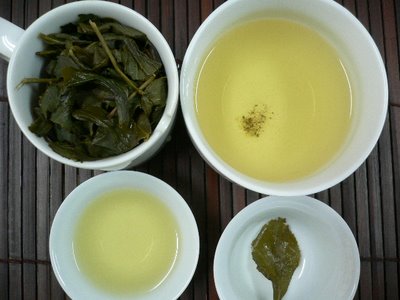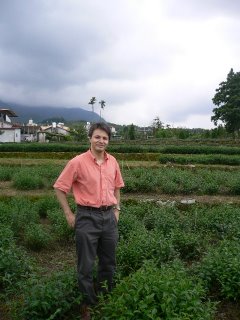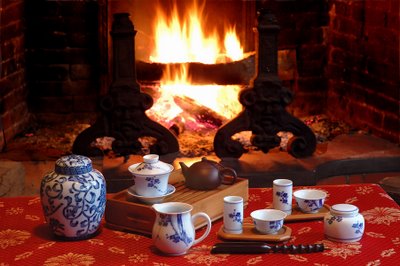
On parle généralement de Gao Shan Cha pour les Oolongs taiwanais récoltés à plus de 1000 mètres de haut. (Gao= haut et Shan = montagne). Depuis une bonne dizaine d'année, ces Oolongs sont devenus les stars des compétitions de thé du centre de Taiwan et les favoris de la majorité des amateurs de thés chinois à Taiwan.
Cet engouement pour les Gao Shan Cha a créé une sorte de course aux étoiles: on plante le Oolong de plus en plus haut sur les nombreuses hautes montagnes de Taiwan. La plus haute, Yu Shan, mesure 3952 mètres. Mais c'est surtout entre Taipei et Hualien qu'on plante en contre-bas des plus hauts pics. Citons Li Shan (Montagne des poires) où l'on cultive aussi beaucoup de fruits (pommes et poires), Tsuei Feng et Da Yu Ling. Da Yu Ling détient d'ailleurs le record de la plantation la plus haute avec 2650 mètres. Je trouve d'ailleurs que ces Oolongs plantés à plus de 2000 mètres méritent un catégorie à part, celle des Oolongs de très haute montagne.
Pour ces Oolongs de très haute montagne, on utilise pratiquement que du luanze Oolong (appelé aussi Qingxin Oolong). Il résiste mieux au froid, mais a un rendement plus faible que les Oolongs Si Ji Chun, Jade ou Jinxuan qu'on retrouvent surtout en plaine. Cela et des terrains en pente difficiles d'accès, uniquement récoltables à la main, expliquent le prix bien supérieur de ces Oolongs. L'entretien des terrains est aussi très couteux car il s'agit de les protéger contre l'érosion et protéger les arbres contre la neige en hiver.
Une autre spécificité du thé de haute et de très haute montagne est son oxidation légère, inférieure à ce qui se faisait traditionnellement en plaine ou bien à Dong Ding. Elle varie en général de 15% pour les plus légers et fleuris à 20% pour les plus forts et fruités. La torréfaction est très légère. On chauffe juste les feuilles à 60-70 degrés pendant 2-3 heures pour éliminer les excès d'eau. Trop d'eau dans les feuilles ferait perdre au thé de sa fraicheur très rapidement après ouverture du paquet. C'est pourquoi il faut bien fermer hermétiquement les paquets d'Oolong léger pour les conserver.
Pour bien comprendre le goût particulier des thés de haute montagne, le mieux est d'étudier ces Oolongs de très haute montagne. (Comme lorsqu'on veut savoir ce qu'est un bon Bordeaux, choisit un Latour, un Margaux et un Haut-Brion pour avoir du Pauillac, du Margaux et du Pessac). Je vous propose donc un petit tour d'horizon avec trois Oolongs de plus de de 2000 mètres.
1. Le Tsuei Feng de 2000 mètres du printemps 2006.

Sa couleur vert claire indique une oxidation légère (15%) qui nous donne des odeurs de fleurs de lys frais. Il a une rondeur veloutée en bouche et finit tout en douceur. Ci-dessus est un résultat après 5 minutes d'infusion. La liqueur reste transparente et ne vire pas au rouge. Aucun défaut en bouche non plus. Il fait presque penser à du Champagne! (D'ailleurs, lors d'un Nouvel j'ai ajouté un tel Oolong fleuri refroidi dans ma coupe de Champagne et le mélange fut fort agréable.)
2. Da Yu Ling (2200 m) de printemps 2006.

Des caractéristiques légères très proches du Tsuei Feng, le Da Yu Ling se caractérise par un bouquet léger et presque froid (il fait froid à plus de 2000 mètres, même à Taiwan). Ses arômes me font penser au lys et à de la lavande fraiche. En plus, son finish est très long et moelleux.
3. Li Shan (2200 mètres) d'hiver 2006/07

Récolté le 31 octobre 2006, cet Oolong se caractérise par une oxidation de 20% qui lui donne sa couleur un peu orangée et son goût fruité et sucré. C'est une façon de faire qui rapproche un peu ces Oolongs de très haute montagne du goût des Oolongs traditionnels (cf. Dong Ding). Mais ils ont la finesse et le qi des sommets en plus. Avec une oxidation plus forte, ces Oolongs se laissent aussi plus facilement torréfiés en vue d'une conservation plus longue.
Ici, on retrouve notamment la pêche fraiche. Pas étonnant pour une montagne productrice de fruits! Je n'ai pu n'en acheter que 600 grammes. Les quantités produites sont plus réduites à cette altitude et les marchands se l'arrachent.
La qualité des Oolongs de haute et de très haute montagne n'est pas forcément meilleure avec la hauteur. Mais il est clair que le potentiel de fraicheur et de pureté (ainsi que le coût) augmente avec les mètres. Par contre, la saison (été) ou bien une récolte lors de conditions peu favorables (manque de soleil pour sécher le thé) peut compromettre la qualité.
Il existe une autre raison pour laquelle le Gao Shan Cha n'est pas toujours sublime: c'est lorsqu'on achète une imitation! Les prix parfois stratosphériques de ces Oolongs ont attiré beaucoup de faussaires. Il s'agit d'ailleurs souvent de producteurs taiwanais qui ont 'délocalisé' toute ou parie de leur production d'Oolong en Asie (Thailande, Vietnam, Indonésie, Birmanie, Chine), et exportent vers Taiwan pour concurrencer les Oolongs locaux avec ces imitations meilleur marché. Les feuilles sèches sont souvent très semblables (car ils utilisent aussi le luanze Oolong). C'est au goût qu'on reconnait d'abord les faussaires: ils n'ont pas le moelleux des Oolongs de Formose. Un goût acre est souvent présent. Les fragrances aussi ne sont pas aussi franches et pures.

 Many thanks to my mom once again! I have received her beautiful tea cloth today! It looks much better in real than in the pictures she had previously sent me. These triangles represent flying geese, she said (a very tradtional american quilt pattern). Each is different and I like the fact that there is a couple of orange ones. They add color and and a touch of 'je ne sais quoi' wild and creative to the tea cloth.
Many thanks to my mom once again! I have received her beautiful tea cloth today! It looks much better in real than in the pictures she had previously sent me. These triangles represent flying geese, she said (a very tradtional american quilt pattern). Each is different and I like the fact that there is a couple of orange ones. They add color and and a touch of 'je ne sais quoi' wild and creative to the tea cloth.

































